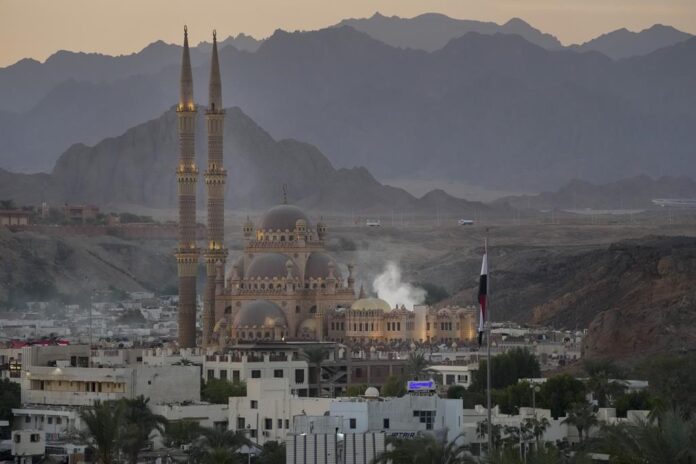COP27 is underway in Egypt and as one of Canada’s biggest emitters, Alberta has a big role to play.
Representatives from the Alberta government, industry representatives, public interest groups as well as researchers are all part of the United Nation’s climate summit.
The provincial government declined to participate in last year’s “Conference of the Parties” under then Premier Jason Kenney.
“I think it was a mistake to not be there,” said Minister of Environment and Protected Areas, Sonya Savage. This year, she’s leading a five member delegation.
She suggests if the provincial government isn’t there, “the federal government will commit to targets and outcomes and dates that aren’t achievable. We’ve seen that in the past.”
“We have to get the balance right between energy security and climate policy otherwise your climate policy runs into reality. And reality has sharp teeth,” added Savage.
“The Canadian delegation to COP27 – as always — will include representatives from many provinces and territories and Canadian companies. They are welcome to attend,” said Environment and Climate Change Canada as part of a statement.
“COP27 is a chance to showcase our leadership in clean-tech innovation and the sustainable solutions to achieve deep emissions reductions aligned with global climate goals.”
Members of the Pathways Alliance, a consortium of Canada’s six largest oilsands companies with a target to achieve net-zero by 2050, are hosting an event and panel presentation in the Canada Pavillion.
“The spirit of why we’re there is to be constructive and helpful and to say, ‘yes we are apart of this problem and we can actually be part of this solution if we all work together’,” said Kendall Dilling, Pathways Alliance president.
The Pembina Institute releasing a study this fall called “Waiting to Launch.” It suggests, “there have been no significant decarbonization investment decisions made by Pathways members.”
Third quarter profits for the top five oil and gas producers this year were over $11 billion.
In October, the Pathways Alliance pledged to spend $16.5 billion before 2030 on a massive proposed carbon capture and storage facility that is the centrepiece of their net-zero-by-2050 pledge.
It will also spend an additional $7.6 billion on other emissions reductions projects, for a total of around $24.1 billion.
Related News
Opinions split over benefits of carbon capture tax credit
“We are, as we speak, investing tens-of-millions — and those will quickly become hundreds-of-millions and billions — and then that’s on top of the billions already invested over the last 20 years to reduce our emissions intensity by about a third,” said Dilling.
READ MORE: Calgary company looks to bring carbon capture hub to Pincher Creek
Albert’s Progress on Carbon Capture and Storage
Alberta sits on some of the largest oil reserves in the world, geology that also gives the province an advantage in carbon capture utilization and storage (CCUS).
“Alberta is probably the leading juristiction in the entire world on CCUS,” said Savage.
The technology also bears the brunt of the province’s current hopes of bringing the oilsands in line with Canada’s current emissions reduction targets, while researchers and industry work on other clean energy technologies.
Alberta Innovates is also bringing some of its latest technology to COP27, showcasing some of the province’s best prospects to deliver on a shared vision for Alberta’s future.
“Those aren’t quite game-day ready, where [carbon capture and storage] really is,” said Dilling.
According to the Pathways Alliance, their carbon capture project is ten times larger than any existing CCUS project in the world.
It involves a 400-kilometre pipeline, connecting 20 or more oilsands facilities and transporting carbon from likes like Fort MacMurray and Christina Lake for permanent storage in the Cold Lake region.
“By 2030 this carbon capture network and storage hub will do about 11 megatonnes of reduction,” said Wes Jickling, with the Canadian Oil Sands Innovation Alliance.
Read more:
Oil Sands Alliance to focus on energy industry sustainability, advancing net zero ambitions
Oilsands operations currently emit roughly 70 megatonnes per year, roughly one-quarter of Alberta’s annual emissions.
In order to complete the network, each company will have to build capture facilities. Dilling said about nine of them have completed pre-engineering studies and the province has approved the pore space.
But there will be additional hurdles, including financing the historically challenging approval of pipelines.
2:18
COP27: Climate financing to be front and centre during conference talks
“If every time we go to build one of these we have these problems that other projects have had and years and years and years of regulatory delays, frankly, a) we’re not going to achieve our national targets, and b) the opportunity is going to pass us by,” said Dilling.
Minister Savage said seeing the project to fruition will be a key talking-point at COP27. “What we need left is to find a path to make that into a reality and to make that financeable and to make it economically viable.”
The federal government is currently offering an investment tax credit for carbon capture projects as conversations on next steps continue.
“Obviously there’s a long ways to go. There’s a lot of things that have to go right to get us to 2030 construction and operation by then. But so far so good,” said Jickling.



